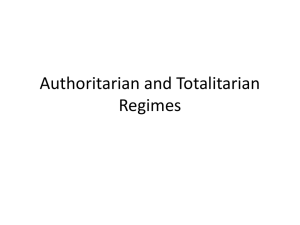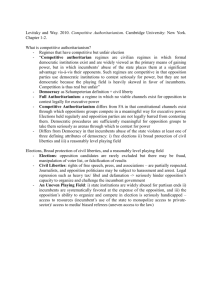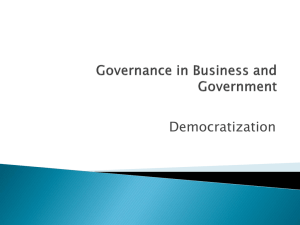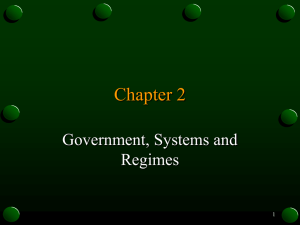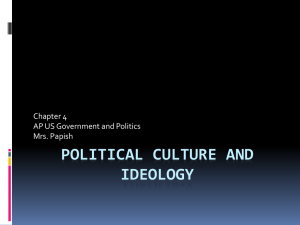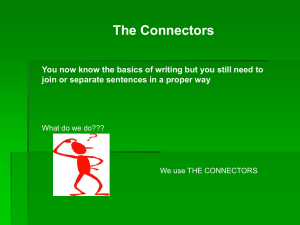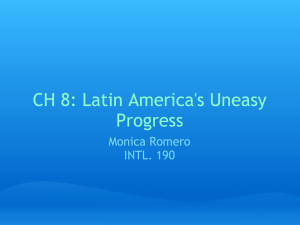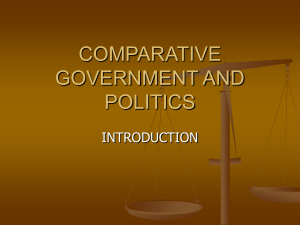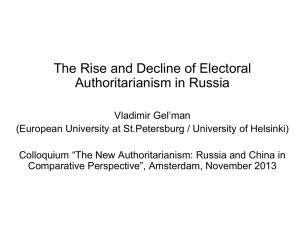Competitive authoritarianism
advertisement
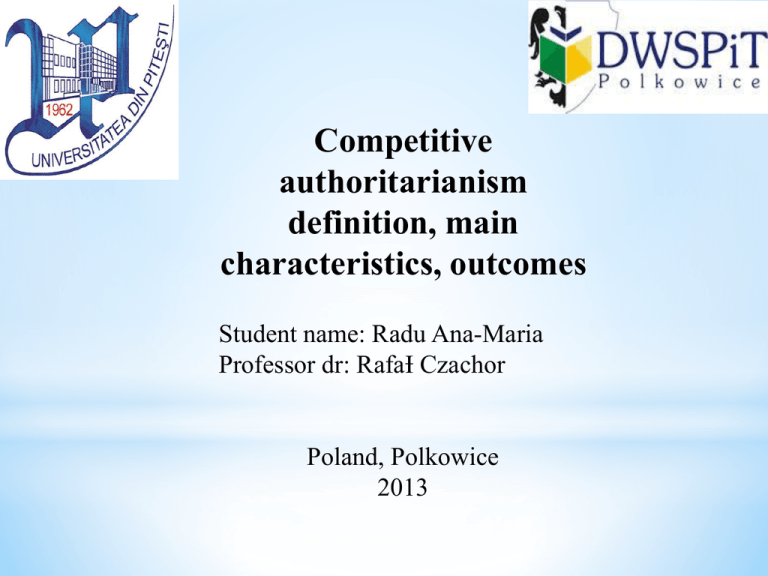
Competitive authoritarianism definition, main characteristics, outcomes Student name: Radu Ana-Maria Professor dr: RafaƗ Czachor Poland, Polkowice 2013 Attention Definition Authoritarianism describes a form of social control characterized by strict obedience to the authority of a state or organization, often maintaining and enforcing control through the use of oppressive measure. Authoritarian regimes are generally considered to be highly hierarchical. Competitive authoritarianism: - A regime that is democratic in appearance but authoritarian in nature - A civilian regime in which democratic institutions exist in form but not in substance, because the electoral, judicial, media, and other institutions are so heavily skewed in favor of current power holders. WHAT IS COMPETITIVE AUTHORITARIANISM? "Politics ... is not like football, deserving a level playing field. Here, you try that and you will be roasted." - Daniel arap Moi, President of Kenya. Competitive authoritarian regimes are civilian regimes in which formal democratic institutions exist and are widely viewed as the primary means of gaining power, but in which incumbents abuse of the state places them at a significant advantage vis-a-vis their opponents. Such regimes are competitive in that opposition parties use democratic institutions to contest seriously for power, but they are not democratic because the playing field is heavily skewed in favor of incumbents. Competition is thus real but unfair. Daniel arap Moi In competitive authoritarian regimes formal democratic institutions exist but incumbents often violate these rules using mechanisms such us bribery, co- optation and other subtle forms of persecution to harass critics in such a way that the regimes fail to meet conventional minimum standards of democracy. However, democratic contestation is possible. Hybrid regimes: - Combination of democratic and authoritarian elements - Proliferation after the Cold War - Are not unidirectional The end of the Cold War posed a fundamental challenge to authoritarianism. Single-party and military dictatorships collapsed throughout post-communist Eurasia, Africa, and much of Asia and Latin America. At the same time, the formal architecture of democracyparticularly multiparty elections diffused widely across the globe. Do you think that at the end of the Cold War the most of the countries have opted for democracy? Transitions didn't always lead to democracy, however. In much of Africa, the former Soviet Union, and in parts of Central and South-Eastern Europe, East Asia, and the Americas, new regimes combined electoral competition with varying degrees of authoritarianism. Unlike the single-party or military autocracies that predominated during the Cold War, regimes in Kenya, Malaysia, Mexico, Peru, Russia, Serbia, Slovakia, Taiwan, Zambia, Zimbabwe, and elsewhere were competitive, in that opposition forces used democratic institutions to contest vigorously—and at times successfully—for power. Nevertheless, these regimes were not democratic. Government critics suffered harassment, arrest, and in some cases, violent attacks, and electoral fraud, unfair media access, and abuse of state resources skewed the playing field heavily in favor of incumbents. We call such regimes competitive authoritarian. Competitive authoritarian regimes proliferated during the post-Cold War period. In 1995, at least 36 regimes were competitive authoritarian, which exceeded the number of democracies among developing and post-communist countries. Kenya Malaysia Mexico Peru Russia Serbia Slovakia Taiwan Zambia Zimbabwe Inattention was rooted in a pronounced democratizing bias that pervaded the post-Cold War literature on regime change. Viewed through the lens of democratization, hybrid regimes were categorized as flawed, incomplete, or “transitional” democracies . Assumed that hybrid regimes are- or should be- moving in a democratic direction. Such assumptions lack empirical foundation. Although some hybrid regimes democratized during the post-Cold War period (Mexico, Slovakia, Taiwan), most didn't. In many cases, regimes remained stable (Malaysia, Tanzania) or became increasingly authoritarian (Belarus, Cambodia, Russia, Zimbabwe). Others were unstable and authoritarian: autocratic incumbents fell but their successors were also autocrats (Georgia, Ukraine, Zambia). Situating the concept Competitive Authoritarianism Democracy Authoritarianism Between Democracy and Closed Authoritarianism Competitive authoritarianism is a hybrid regime type, with characteristics of both democracy and authoritarianism. Comparing Democratic, Competitive Authoritarian and Closed Regimes Democracy Competitive Authoritarianism Full Authoritarianism Status of Core Systematically Democratic respected. Institutions Widely viewed as (Elections, only route to Civil power. Liberties) Competes on Status of more or less equal Opposition footing with Exist and are meaningful, but Nonexistent or reduced Systematically violated in favor of to facade status. incumbent. Not viewed as a viable WideIy viewed as primary route to power. route to power. Major opposition is legal and can Major opposition compete openly, but is significantly banned, or largely disadvantaged by underground or in exile. incumbent abuse. incumbent. Lower than democracy but Level of Uncertainty High higher than full authoritarianism. Low Full authoritarianism It is important to distinguish between competitive and noncompetitive authoritarianism. We define full authoritarianism as a regime in which no viable channels exist for opposition to contest legally for executive power. This category includes closed regimes in which national-level democratic institutions don't exist (for example: China, Cuba, and Saudi Arabia) and hegemonic regimes in which formal democratic institutions exist on paper but are reduced to facade status in practice. Competitive authoritarianism Competitive authoritarian regimes are distinguished from full authoritarianism in that constitutional channels exist through which opposition groups compete in a meaningful way for executive power. Elections are held regularly and opposition parties are not legally barred from contesting them. Opposition activity is above ground: Opposition parties can open offices, recruit candidates, and organize campaigns, and politicians are rarely exiled or imprisoned. In short, democratic procedures are sufficiently meaningful for opposition groups to take them seriously as arenas through which to contest for power. What distinguishes competitive authoritarianism from democracy, however,is the fact that incumbent abuse of the state violates at least one of three defining attributes of democracy: - free elections - broad protection of civil liberties - a reasonably level playing field Main characteristics: - Elections - Civil Liberties - An Uneven Playing Field: - access to resources - access to Media - Biased Referees: Uneven Access to the Law Elections In democracies elections are: -Regularly held -Competitive -Generally free from masiv fraud Examples: - Russia 1996 (communist parties) - Ukraine 1999 - Kenya 1992 and 1997 - Zimbabwe 2000 In competitive authoritarian regimes elections are: - Competitive, in that major opposition candidates are not excluded - Opposition parties are able to campaign publicly - There is no massive fraud - Unfree and almost always unfair Examples: - Dominican Republic 1994 - Ukraine 2004 - Serbia 2000 Civil Liberties In democracies, a broad range of civil liberties, including rights of free speech and association, and a free press, are broadly protected. Although these rights may be violated, such violations are infrequent and do not seriously hinder the opposition’s capacity to challenge incumbents. In closed regimes, basic civil liberties generally either do not exist or exist on paper but are so systematically violated that citizens, civic and opposition groups, and media are not even minimally protected from state abuse (for example Kazakhstan, Uzbekistan). As a result, much opposition activity takes place either underground or in exile. Measures political rights (PL) and civil liberties (CL) on a one-to-seven scale. One represents the highest degree of “freedom” and seven the lowest. In competitive authoritarian regimes, basic civil liberties are formally guaranteed and are to some extent protected in practice. Independent media exist and civic and opposition groups are able to operate above ground, opening offices, holding public meetings and demonstrations, and criticizing the government in the media. Yet civil liberties are frequently violated. Opposition politicians, independent judges, journalists, human rights activists, and other government critics are subject to harassment, arrest, and in some cases, violent attacks. In some regimes, overt repression-including the arrest of opposition figures (Belarus, Cambodia), killing of opposition activists (Cambodia, Haiti, Kenya, Zimbabwe), violent repression of protest (Cambodia, Ethiopia, Kenya), or closure of independent media (Russia, Zimbabwe) is widespread, pushing regimes toward full-scale authoritarianism. Although civil liberties violations in competitive authoritarian regimes are not systematic or severe enough to force opposition underground or into exile, they clearly exceed what is permissible in a democracy. An Uneven Playing Field Finally, competitive authoritarian regimes are characterized by a highly uneven playing field between incumbents and opposition. Although a degree of incumbent advantage exists in all democracies, and although many new democracies are characterized by widespread clientelism and politicization of state bureaucracies, not all forms of incumbent advantage are compatible with democracy. The question of where to draw the line between “acceptable” incumbent advantage and a truly uneven playing field is a difficult one. We employ the following criteria: an uneven playing field exists where (1) state institutions are widely abused for partisan ends; (2) the incumbent party is systematically favored at the expense of the opposition; and (3) the opposition’s ability to organize and compete in elections is seriously handicapped. Three aspects of an uneven playing field are of particular importance: access to resources; access to media; access to the law. Access to resources Access to resources is uneven where incumbents use the state to create or maintain resource disparities that hinder the opposition’s ability to compete. Incumbents may make direct partisan use of state resources, while denying other parties access to those resources. In a few cases, this state financing is legal. The executive branch made use of large “secret funds” to finance Socialist campaigns, which went “a long way to compromise equal chances of candidates”. Incumbents may also make systematic use of the state’s infrastructure- including buildings, vehicles, communications equipment, and personnel- for electoral campaigns. Incumbents may use the state to monopolize access to private sector finance. Governing parties may use discretionary control over credit, licenses, state contracts, and other resources to enrich themselves via party owned enterprises (Taiwan), benefit crony proxy-owned firms that then contribute money back into party coffers (Malaysia), or simply corner the market in private sector donations (Mexico, Russia). Access to Media Where opposition parties do not enjoy access to media that reaches the bulk of the population, there is no possibility of fair competition. Media access may be denied in several ways. Frequently, the most important disparities existed in access to electronic media (television and radio), combined with highly biased and partisan coverage. In many post- Cold War regimes, the state maintained a monopoly over television and most- if not all- radio broadcasting. Although print media was often pluralist, with a diversity of independent newspapers and magazines circulating freely, these papers were often confined to a small urban elite. In poor, predominately rural societies (for example much of Africa), only a tiny fraction of the population read newspapers. In such cases, if radio and television are in the hands of the state, and state-run channels are biased in favor of the governing party, opposition forces are effectively denied access to the media. Access to the Law In many competitive authoritarian regimes, the courts, electoral authorities, and other nominally independent arbiters of the rules of the game are not only controlled by incumbents (via packing, blackmail, bribery, or intimidation) but also are systematically employed as partisan tools against the opposition. Consequently, in electoral, judicial, and other critical disputes, agencies that are designed to act as referees rule systematically in favor of incumbents. Incumbent manipulation of the legal system may affect political competition in several ways: - where the judiciary is solidly under the control of the governing party, the government may violate democratic procedure with impunity. - incumbents may engage in “legal” repression, or the discretionary use of legal instruments- such as tax, libel, or defamation laws- as a weapon against opponents or the media. In many competitive authoritarian regimes incumbents pack judiciaries , electoral comissions, and other nominally independent arbiters and manipulate via blackmail, bribery, and/or intimidation. As a result, legal and other state agencies that are designed to act as referees rule systematically in favor of incumbents. This allows incumbents to engage in illicit acts- including violations of democratic procedure – with impunity. It also ensures that critical electoral, legal, or other disputes will be resolved in the incumbent’s favor. THE RISE OF COMPETITIVE AUTHORITARIANISM “ [ Why liberalize?] When you see your neighbor being shaved, you should wet your beard. Otherwise you could get a rough shave.” Julius Nyerere, President of Tanzania “ Don't you know how these Westerners are? They will make a fuss [about electoral fraud] for a few days, and then they will calm down and life will go on as usual.” Eduard Shevardnadze, President of Georgia Competitive authoritarianism is a post-Cold War phenomenon. Although a few competitive authoritarian regimes existed during the interwar and Cold War periods, they proliferated after the fall of the Berlin Wall. Key changes in the international environment created conditions that were highly favorable to the emergence and survival of competitive authoritarian regimes. The end of the Cold War led to a withdrawal of external support for many superpower-sponsored dictatorships. Beginning in the late 1980s, both Sovietand U.S.-backed dictatorships faced a precipitous decline in external military and economic assistance, which eroded the capacity of many autocrats to maintain themselves in power. States became bankrupted, patronage resources disappeared, and in many cases, coercive apparatuses began to disintegrate, leaving autocrats with little choice but to liberalize or abandon power. Outcomes Diverging Outcomes: Competitive Authoritarian Regime Trajectories, 1990-2008 Competitive authoritarian regimes are marked by an inherent tension. The existence of meaningful democratic institutions creates arenas of contestation through which oppositions may legally- and legitimately- challenge incumbents. At limes, authoritarian governments manage these arenas of contestation without difficulty. When incumbents enjoy broad public support and/or face very weak opposition, they may retain power without egregiously violating democratic institutions. However, the existence of multiparty elections, nominally independent legislatures, judiciaries, and media creates opportunities for periodic challenges, and when incumbents lack public support, these challenges may be regime-threatening. Most frequently, opposition challenges take place at the ballot box, as in Serbia (2000), Kenya (2002), Ukraine (2004), and Zimbabwe (2008). However, they also may emerge from parliament (for example Russia in 1993 and Belarus in 1996) or the judiciary. Competitive authoritarian regimes followed three distinct paths between 1990 and 2008 (Table). - The first is democratization, or the establishment of free and fair elections, broad protection of civil liberties, and a level playing field. Democratization may be overseen by authoritarian governments. - The second outcome is unstable authoritarianism, or cases that undergo one or more transition but do not democratize. In these cases, authoritarian incumbents were removed at least once but new governments were not democratic. Successors inherited a skewed playing field and politicized state institutions, which they used to weaken and/or disadvantage their opponents. - The third outcome is stable authoritarianism. In these cases, authoritarian incumbents or their chosen successors remained in power for at least three presidential/ parliamentary terms following the establishment of competitive authoritarian rule. This diversity of outcomes challenges the democratizing assumptions that underlie much of the post—Cold War literature on regime change. Neither the breakdown of authoritarian regimes nor the holding of multiparty elections necessarily led to democratization during the post-Cold War period. Competitive Authoritarian Regimes Trajectories 1990- 2008 Democratization Benin Croatia Dominican Republic Ghana Guyana Macedonia Mali Mexico Nicaragua Peru Romania Serbia Slovakia Taiwan Ukraine Unstable Authoritarianism Stable Authoritarianism Albania Belarus Georgia Haiti Kenya Madagascar Malawi Moldova Senegal Zambia Armenia Botswana Cambodia Cameroon Gabon Malaysia Mozambique Russia Tanzania Zimbabwe Linkage, Incumbent Capacity and Regime Outcomes Conclusion Disincentives for party- building were particularly strong in the post-Cold War period, as politicians could rely on mass media, rather than organization, to make electoral appeals. Consequently, where post-Cold War incumbents did not inherit strong parties- as in Haiti, Peru, and much of African and the former Soviet Union- governing parties were almost invariably weak. Post-Cold War regime outcomes are far more patterned than contingency, choice centered, and institutional design approaches would suggest. In fact, two broad structural factors- linkage and the organizational power of incumbents- take us a considerable way toward explaining variation in the trajectory of post-Cold War competitive authoritarian regimes. Authoritarian methods do not produce independence: they reinforce dependence. Elaine Heffner Bibliography • Steven Levitsky, Lucan A. Way, Competitive Authoritarianism, Hybrid Regimes After the Cold War, Cambridge, University Press, 2010 • • • • http://iis-db.stanford.edu/evnts/4396/Levitsky-WayStanford.pdf http://www.scrigroup.com/istorie-politica/stiintepolitice/Regimuri-politice-autoritare71484.php http://authoritarianism.askdefine.com/ http://www.joeldiana.com/downloads/guru_papers/Gur uPapersDEMOCRACY9-12v12.pdf
